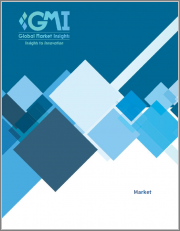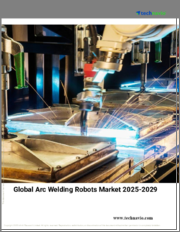
|
시장보고서
상품코드
1395067
용접 로봇 시장 : 유형별, 페이로드별, 부품별, 최종 용도별, 예측(2023-2032년)Robotics Welding Market - By Type (Arc Welding, Spot Welding, MIG, TIG, Laser welding), By Payload (<50 kg Payload, 50-150 kg Payload, >150 kg Payload), By Component (Hardware, Software, Services), By End Use, Forecast, 2023 - 2032 |
||||||
용접 로봇 시장은 제조업의 자동화 발전과 효율성 추구로 인해 2023년부터 2032년까지 10% 이상의 연평균 복합 성장률(CAGR)을 나타낼 것으로 예측됩니다.
로봇은 용접 공정에서 정확성, 속도 및 일관성을 제공하여 생산량을 늘리고 제품 품질을 향상시킬 수 있습니다.
또한 자동 용접 시스템은 흄이나 고온과 같은 위험한 상황에 노출될 기회를 줄여 작업자의 안전성을 높입니다. 인건비 절감, 오류율 감소, 생산 속도 향상에 따른 장기적인 비용 절감으로 인해 용접 로봇은 업계 기업들에게 매력적인 투자처가 되고 있습니다. 예를 들어, 2023년 7월, Ficep UK는 AGT Robotics와 함께 숙련된 노동력 부족을 해결하고 생산성을 향상시키는 고품질 용접 시스템에 대한 수요에 대응하기 위해 새로운 자동 및 로봇 가공 솔루션인 Sabre를 발표했습니다.
50-150kg의 페이로드 부문은 다양한 산업용 용접 작업의 다양성과 효율성으로 인해 2032년까지 빠른 속도로 성장할 것으로 예상됩니다. 이 페이로드 범위는 무거운 자재 취급과 기동성 사이에서 균형을 이룹니다. 자동차, 조선, 건설 등 다양한 생산 요구사항이 있는 산업에서 이 페이로드는 대규모 프로젝트와 복잡한 용접 용도를 모두 처리할 수 있는 최적의 선택이 될 것입니다.
소프트웨어 분야는 예측 기간 동안 고급 솔루션이 실시간 모니터링, 지능형 제어 알고리즘, 다른 제조 시스템과의 원활한 통합을 제공하기 때문에 큰 성장률을 나타낼 것으로 예측됩니다. 이러한 통합은 용접 로봇 생태계 내 통신과 조정을 강화합니다. 정교한 프로그래밍 및 시뮬레이션 도구의 등장으로 제조업체는 공정을 미세 조정하고, 정확도를 높이며, 진화하는 생산 수요에 더욱 신속하게 대응할 수 있게 됐습니다.
유럽의 용접 로봇 산업은 2032년까지 빠른 속도로 성장할 것으로 예상됩니다. 생산성과 제품 품질이 중시되는 자동차 산업과 제조 산업에서 이 제품의 채택이 가속화되고 있습니다. 로봇 공학은 지속 가능한 제조 관행에 따라 인간 작업자가 위험한 용접 환경에 노출되는 것을 크게 줄입니다. 엄격한 안전 규정과 인더스트리 4.0에 대한 노력은 유럽에서 산업 확장을 더욱 촉진할 것입니다.
목차
제1장 조사 방법과 조사 범위
제2장 주요 요약
제3장 용접 로봇 시장 : 산업 인사이트
- COVID-19에 대한 영향
- 러시아·우크라이나 전쟁의 영향
- 생태계 분석
- 벤더 매트릭스
- 이익률 분석
- 페이로드와 혁신 전망
- 특허 분석
- 주요 뉴스와 이니셔티브
- 규제 상황
- 영향요인
- 성장 촉진요인
- 업계의 잠재적 리스크&과제
- 성장 가능성 분석
- Porter's Five Forces 분석
- PESTEL 분석
제4장 경쟁 구도
- 서론
- 기업별 시장 점유율
- 주요 시장 기업 - 경쟁 분석
- ABB Ltd.
- Daihen Corporation
- Fanuc Corporation
- Kawasaki Heavy Industries, Ltd.
- Kuka AG
- Panasonic Corporation
- Yaskawa Electric Corporation
- 경쟁 포지셔닝 매트릭스
- 전략 전망 매트릭스
제5장 용접 로봇 시장 추정·예측 : 유형별
- 주요 동향 : 유형별
- 아크 용접
- 스팟 용접
- MIG (Metal Inert Gas)
- TIG (Tungsten Inert Gas)
- 레이저 용접
- 기타
제6장 용접 로봇 시장 추정·예측 : 페이로드별
- 주요 동향 : 페이로드별
- 50kg 미만
- 50-150kg
- 150kg 이상
제7장 용접 로봇 시장 추정·예측 : 컴포넌트별
- 주요 동향 : 컴포넌트별
- 하드웨어
- 로봇
- 용접 장비
- 센서 및 비전 시스템
- 소프트웨어
- 컨트롤러 및 소프트웨어
- 프로그래밍 툴
- 시뮬레이션 소프트웨어
- 서비스
제8장 용접 로봇 시장 추정·예측 : 최종 용도별
- 주요 동향 : 용도별
- 자동차 및 운송
- 금속 및 기계
- 전기 및 전자
- 항공우주 및 방위
- 기타
제9장 용접 로봇 시장 추정·예측 : 지역별
- 주요 동향 : 지역별
- 북미
- 미국
- 캐나다
- 유럽
- 영국
- 독일
- 프랑스
- 이탈리아
- 스페인
- 기타 유럽
- 아시아태평양
- 중국
- 인도
- 일본
- 한국
- 뉴질랜드
- 기타 아시아태평양
- 라틴아메리카
- 브라질
- 멕시코
- 기타 라틴아메리카
- 중동 및 아프리카
- 사우디아라비아
- 아랍에미리트(UAE)
- 남아프리카공화국
- 기타 MEA
제10장 기업 개요
- ABB Ltd.
- Daihen Corporation
- Estun Automation Co., Ltd.
- EVS TECH CO., LTD
- Fanuc Corporation
- IGM ROBOTERSYSTEME AG
- Kawasaki Heavy Industries, Ltd.
- Kuka AG
- NACHI-FUJIKOSHI CORP.
- Panasonic Corporation
- UNITED PROARC CORPORATION
- Yaskawa Electric Corporation
Robotics Welding Market is anticipated to record a CAGR of over 10% during 2023-2032, driven by the rising automation in manufacturing, and the pursuit of enhanced efficiency. The robots offer precision, speed, and consistency in welding processes, leading to higher production outputs and improved product quality.
Additionally, automated welding systems enhance worker safety by decreasing exposure to hazardous conditions, such as fumes and high temperatures. The long-term cost savings associated with reduced labor costs, lower error rates, and enhanced production rates make robotics welding an attractive investment for industries players. For instance, in July 2023, Ficep UK, in collaboration with AGT Robotics, launched a new automatic and robotic processing solution Sabre in response to the demand for a quality welding system to address skilled labor shortages and increase productivity.
The overall robotics welding market is divided on the basis of type, payload, component, end use, and region.
The 50-150 kg payload segment will grow at a notable pace through 2032, owing to its versatile applicability and efficiency across various industrial welding tasks. This payload range strikes a balance between handling heavy materials and ensuring maneuverability. Industries with varying production requirements, such as automotive, shipbuilding, and construction, find this payload optimal as it accommodates both larger-scale projects and intricate welding applications.
The software segment is poised to record significant growth rate over the forecast period as advanced solutions offer real-time monitoring, intelligent control algorithms, and seamless integration with other manufacturing systems. This integration allows for enhanced communication and coordination within the robotic welding ecosystem. The advent of sophisticated programming and simulation tools further empowers manufacturers to fine-tune the processes, improve accuracy, and swiftly adapt to evolving production demand.
Europe robotic welding industry is anticipated to grow at a significant pace through 2032. With a strong emphasis on productivity and product quality, automotive and manufacturing industries are witnessing heightened adoption of the product. Robotics significantly decreases the exposure of human workers to hazardous welding environments, following sustainable manufacturing practices. Stringent safety regulations and industry 4.0 initiatives will further bolster the industry expansion in Europe.
Table of Contents
Chapter 1 Methodology & Scope
- 1.1 Market scope & definition
- 1.2 Base estimates & calculations
- 1.3 Forecast calculation
- 1.4 Data Sources
- 1.4.1 Primary
- 1.4.2 Secondary
- 1.4.2.1 Paid sources
- 1.4.2.2 Public sources
Chapter 2 Executive Summary
- 2.1 Robotics welding market 360 degree synopsis, 2018 - 2032
- 2.2 Business trends
- 2.2.1 Total addressable market (TAM), 2023-2032
- 2.3 Regional trends
- 2.4 Type trends
- 2.5 Payload trends
- 2.6 Component trends
- 2.7 End-use trends
Chapter 3 Robotics Welding Market Industry Insights
- 3.1 Impact on COVID-19
- 3.2 Russia- Ukraine war impact
- 3.3 Industry ecosystem analysis
- 3.4 Vendor matrix
- 3.5 Profit margin analysis
- 3.6 Payload & innovation landscape
- 3.7 Patent analysis
- 3.8 Key news and initiatives
- 3.9 Regulatory landscape
- 3.10 Impact forces
- 3.10.1 Growth drivers
- 3.10.1.1 Intensify adoption of industry 4.0 principles
- 3.10.1.2 Increasing adoption of welding robots in automotive and transportation industries
- 3.10.1.3 Ongoing penetration of 5G in industrial manufacturing
- 3.10.1.4 Systems offer high levels of automation and efficiency.
- 3.10.1.5 Growing demand for high-quality products
- 3.10.2 Industry pitfalls & challenges
- 3.10.2.1 Perceived notion of losing jobs due to automation
- 3.10.2.2 High initial costs associated with installation of welding robots for SME
- 3.10.1 Growth drivers
- 3.11 Growth potential analysis
- 3.12 Porter's analysis
- 3.13 PESTEL analysis
Chapter 4 Competitive Landscape, 2022
- 4.1 Introduction
- 4.2 Company market share, 2022
- 4.3 Competitive analysis of major market players, 2022
- 4.3.1 ABB Ltd.
- 4.3.2 Daihen Corporation
- 4.3.3 Fanuc Corporation
- 4.3.4 Kawasaki Heavy Industries, Ltd.
- 4.3.5 Kuka AG
- 4.3.6 Panasonic Corporation
- 4.3.7 Yaskawa Electric Corporation
- 4.4 Competitive positioning matrix, 2022
- 4.5 Strategic outlook matrix, 2022
Chapter 5 Robotics Welding Market Estimates & Forecast, By Type (USD Million)
- 5.1 Key trends, by type
- 5.2 Arc Welding
- 5.3 Spot Welding
- 5.4 MIG (Metal Inert Gas)
- 5.5 TIG (Tungsten Inert Gas)
- 5.6 Laser welding
- 5.7 Others
Chapter 6 Robotics Welding Market Estimates & Forecast, By Payload (USD Million)
- 6.1 Key trends, by payload
- 6.2 <50 kg Payload
- 6.3 50-150 kg Payload
- 6.4 150 kg Payload
Chapter 7 Robotics Welding Market Estimates & Forecast, By component (USD Million)
- 7.1 Key trends, by component
- 7.2 Hardware
- 7.2.1 Robots
- 7.2.2 Welding Equipment
- 7.2.3 Sensors and Vision Systems
- 7.3 Software
- 7.3.1 Controller and Software
- 7.3.2 Programming Tools
- 7.3.3 Simulation Software
- 7.4 Services
Chapter 8 Robotics Welding Market Estimates & Forecast, By End-use (USD Million)
- 8.1 Key trends, by end-use
- 8.2 Automotive & transportation
- 8.3 Metals & machinery
- 8.4 Electrical & electronics
- 8.5 Aerospace & defense
- 8.6 Others
Chapter 9 Robotics Welding market Estimates & Forecast, By Region (USD Million)
- 9.1 Key trends, by region
- 9.2 North America
- 9.2.1 U.S.
- 9.2.2 Canada
- 9.3 Europe
- 9.3.1 UK
- 9.3.2 Germany
- 9.3.3 France
- 9.3.4 Italy
- 9.3.5 Spain
- 9.3.6 Rest of Europe
- 9.4 Asia Pacific
- 9.4.1 China
- 9.4.2 India
- 9.4.3 Japan
- 9.4.4 South Korea
- 9.4.5 ANZ
- 9.4.6 Rest of Asia Pacific
- 9.5 Latin America
- 9.5.1 Brazil
- 9.5.2 Mexico
- 9.5.3 Rest of Latin America
- 9.6 MEA
- 9.6.1 Saudi Arabia
- 9.6.2 UAE
- 9.6.3 South Africa
- 9.6.4 Rest of MEA
Chapter 10 Company Profiles (Business Overview, Financial Overview, Product Landscape, Strategic Outlook, SWOT Analysis)
- 10.1 ABB Ltd.
- 10.2 Daihen Corporation
- 10.3 Estun Automation Co., Ltd.
- 10.4 EVS TECH CO., LTD
- 10.5 Fanuc Corporation
- 10.6 IGM ROBOTERSYSTEME AG
- 10.7 Kawasaki Heavy Industries, Ltd.
- 10.8 Kuka AG
- 10.9 NACHI-FUJIKOSHI CORP.
- 10.10 Panasonic Corporation
- 10.11 UNITED PROARC CORPORATION
- 10.12 Yaskawa Electric Corporation



















